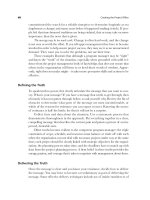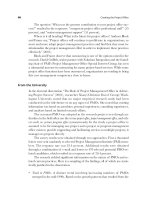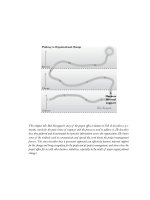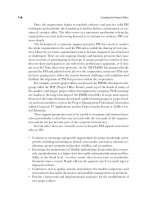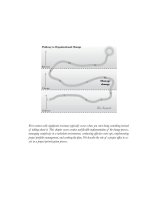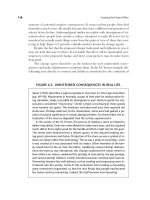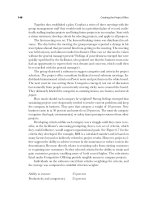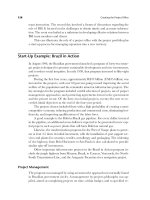Tài liệu Creating the project office 29 doc
Bạn đang xem bản rút gọn của tài liệu. Xem và tải ngay bản đầy đủ của tài liệu tại đây (58.28 KB, 10 trang )
Steps to a Project-Friendly Culture
To sustain the change necessary to fundamentally improve project management
as a core business process, the project management office (PMO) can engage in
the steps outlined in this section. In some cases the PMO may be able to take the
steps directly, and in other cases it may simply become the catalyst to influence
other forces in the organization to engage. The steps are based on nine success
factors defined in PEAT, which in turn are based on the research and writing of
Graham and Englund (1997) and Cohen and Graham (2001). For each success
factor we list actions and describe what success looks like to sustain the change.
These are grouped by L
2
M
2
categories. In addition, for each success factor there is
a discussion of the cultural implications of organizational change. We point out
existing cultural values that may enable the change to a project-friendly culture
and those existing cultural traits that may inhibit such a change.
Strategic Emphasis
Strategic emphasis, the first success factor from PEAT, is an indicator of how well
the company aligns projects with its business strategy. To do this there should be a
sound project selection process in place supported by the upper management
team. Business strategy should be developed, well articulated, and understood by
the project manager and team members. There are a number of enablers associ-
ated with each of the four categories of L
2
M
2
to promote the needed change in
this area and consolidate it into the organizational culture.
In the Leadership area the PMO can emphasize the following enablers. Com-
municating strategy to project managers and team members and framing the strat-
egy so project trade-offs are clearly connected to strategy implementation will
begin to equip people to incorporate strategy in their decision making and project
implementation. Developing a policy and process for incorporating strategic pri-
orities in the project selection process will help each project begin with strategy in
mind. If leaders communicate the big picture to project managers and team mem-
bers through formal and informal communication channels such as meetings,
e-mail, and newsletters, this reinforces the strategic direction.
Develop a standard policy that mandates a process for each project in the
portfolio to define the final goal statement. Include heavy project team involve-
ment along with final approval by upper management. Also develop an interac-
tive process between directed strategy as articulated by upper management and
emergent strategy as implemented by project personnel, producing a realized strat-
egy that is realistic and adds value to the company (Cohen and Graham, 2001,
258 Creating the Project Office
pp. 64–68). Management can also specify functional manager roles in supporting
team members’ project work, along with ways for projects to develop measures of
success that facilitate agreement with functional managers. This will also help to
align and strengthen strategy implementation.
In the Learning area the PMO can train project managers and team mem-
bers so they are proficient in applying company strategic priorities to their project
work. They can also train project managers to work with Finance and Marketing
to develop a business case or to understand the business case that Finance and
Marketing develop. Training project sponsors and selection board members to
use strategic priorities in their selection process supports a strategic project port-
folio. When project managers and team members learn strategic business acumen
for project success, they are better able to apply sound business decision making
in their projects. Training project managers and team members to construct goal
statements that include both the individual project goal and the link to strategy
also reinforces strategic alignment. Training upper managers to engage the team
in an interactive process to develop the final goal statement further supports strat-
egy implementation. Also train functional managers on project management best
practices to support the project, and train project managers on how to develop
realistic and relevant measures of success at the beginning of the project.
For Means, a PMO can include the development of a checklist or process to
help project managers and team members think through the strategic priorities
of each project and determine alignment with corporate strategy. Supply tem-
plates, procedures, and standard criteria to help in the selection process. Actors
also need time for training as well as follow-up reference materials, decision aids,
and other performance support resources. Management needs to provide both
the time needed by the team to develop goal statements and a process template
or support tool for the team to use. Finally, management systems can allocate time
needed for functional personnel to support project work and provide processes to
include functional support. Progress becomes evident when there are measures of
success and a process for tracking project outcome life cycles to collect the data
needed to measure success over the long run.
Motivation reinforcement can include project sponsors and review board
members asking about how the project supports strategy, offering recognition for
good work in this area, and suggesting remedial work to correct deficiencies.
Strategic alignment should be identified for any project before moving from ini-
tiating to planning. The PMO makes the selection board members and project
managers accountable for the business success of their projects through a perfor-
mance management system. Reinforcing desired behaviors through informal re-
wards and recognition helps to motivate everyone to manage the project portfolio
and individual projects with strategy in mind.
Looking Forward 259
Project sponsors and review board members can engage project managers
and team members in a dialogue about the big picture. Make this an agenda item
during periodic reviews. It is motivating to recognize and reward good goal state-
ments in the review process. Functional managers’ performance management
evaluations can include an evaluation of how well they support their direct re-
ports’ project work. Recognize and reward project managers and teams based on
short- and long-term measures of success that are linked to strategic alignment.
Basic cultural assumptions that would block this success factor include be-
lieving that strategy does not matter because companies cannot influence their
own destiny by developing a strategy. Another inhibiting basic assumption would
be that strategy is a top secret plan that only upper management should be ex-
posed to. If upper management believes that they should be the font of all truth
and simply direct those below them in what to do, this, too, would get in the way
of success.
Enabling the strategic emphasis success factor would be basic assumptions that
important decisions can be made at the project level as emerging strategy to align
project decisions with directed strategy. Another would be that strategy is important
and that it should be communicated throughout the organization. In an organiza-
tional culture where upper management assumes that strategy is implemented sim-
ply by being articulated, this success factor will have a low probability of success. In
a culture that explicitly focuses on the execution of strategy after it has been artic-
ulated and emphasizes the interaction of directed strategy with emerging strategy
to create realized strategy, it has a greater chance for success.
Upper Management Support
Upper management support is the second PEAT success factor. This factor is
based on the fact that projects are not really separate from the management struc-
ture of the organization. They are embedded in it. Without support by manage-
ment for projects and for the process that ensures successful projects, the
organization suffers. Upper management needs to support each project in the first
place and to continue to support project managers even when they stumble. Upper
managers need to refrain from interfering in day-to-day project management.
Most important, they should fully support project management best practices in
the organization.
For Leadership, the PMO can specify the project management process in-
cluding the roles and responsibilities of project sponsors, review board members,
and functional managers to support the project and process. It can specify the role
of project sponsor as a formal part of the project management process and de-
fine the sponsor’s proper planning role in the project process. Another important
260 Creating the Project Office
supporting factor is for leaders to emphasize how important planning is for ulti-
mate project success and how upper management should support the planning
process. Leaders can communicate reciprocal roles and responsibilities between
upper management and project managers in the project management process.
They can stipulate how negotiations should occur on issues of project goals, pri-
ority of constraints, and major milestones as well as the stage-gate project review
process. Designating the team’s important processes as a formal part of project
management helps to support teamwork. Communicating how important it is for
everyone to follow and support project management best practices helps build the
legitimacy of these practices in the organization.
For Learning, the PMO can train upper managers about the project manage-
ment process, their roles and responsibilities, and how they can support an envi-
ronment that enables projects for business results. In such training sessions, upper
managers often say that they did not realize that project management is often coun-
terintuitive from a standard department manager’s point of view. Training sponsors
and project managers in their reciprocal roles and responsibilities for managing
projects also provides further support for projects. Convince and train upper man-
agers to support the planning process. Help them understand why planning is so
important and how it supports their goals for reducing project cycle time. Give upper
managers and project managers learning opportunities to work together. Develop
a roles and responsibilities matrix that specifies responsibilities of each role at the
beginning of the project; this helps to avoid upper management interference.
To provide the Means necessary for the change, the PMO can develop guides,
templates, Web sites, and job aids to help upper managers remember and execute
their roles and responsibilities. Reinforce learning. Recognize the sponsor role as
formal work and provide the time needed to carry out the responsibilities, or the
work will always become “my other work” that never gets done. Provide guide-
lines, coaching, job aids, and performance support tools to support the roles. Spec-
ify responsibilities in relation to other organizational roles so that the sponsor has
enough authority to prevail in conflicts with other managers. Furnish guidelines
and other reminders to help upper management remember their role in support-
ing the planning process. Specify the project team’s requirements for time to plan,
and provide performance support tools based on the specified process and guide-
lines. Developing a roles and responsibilities matrix to illustrate the suggested re-
lationships between upper management and the project manager and team will
facilitate negotiations on how they work together. This means that the process also
allows for flexibility to adjust for circumstances and style. Everyone needs time al-
located to follow these core processes.
For Motivation, executives need to recognize and reward upper management
behavior that supports the project management process and discourages behavior
Looking Forward 261
that does not. Sponsors and review board members should be held accountable
not only for project results but for following project processes as well. Functional
managers also need to be accountable for their work on projects. Provide infor-
mal rewards and recognition for good processes and remedial actions for poor
processes. Hold sponsors and review board members accountable for supporting
sufficient planning. All players—upper managers with project responsibilities,
project managers, and team members—should be accountable for short- and
long-term project success. Provide informal recognition for those who engage in
the preferred process. Hold formal project reviews that include process reviews.
Basic cultural assumptions that may inhibit the change include any that con-
tradict project management best practices. For instance, in a culture that does not
regard planning as a productive activity, it will be difficult to encourage upper
management to support project-planning processes. Basic assumptions of hierar-
chy as micromanagement with a tight chain of command may inhibit the change.
Another inhibitor is a basic assumption that there is never enough time to really
engage in process.
Assumptions that would enable the process include those that value process
in general. An assumption that there is always enough time to do something the
right way is extremely helpful. A basic assumption that it is acceptable, useful, and
expected for subordinates and bosses to negotiate over deadlines, budgets, and
specifications also enables this success factor.
Project Planning Support
Project planning support, the third PEAT success factor, emphasizes the impor-
tance to project success of having the team participate in an extensive planning
process to align everyone on the triple constraints and business goals of the project.
The planning process should specify deliverables, lay out milestones, and use his-
torical data from past projects. Include a budget, business plan, and risk plan. The
deadline specified in the project should be realistic in the eyes of the team. The
project manager cannot do this alone. Without the support of the project team and
other major stakeholders, it will not happen. All roles must be supported by L
2
M
2
.
To provide Leadership, the PMO should specify the planning process as part
of the project management process. It must emphasize that the participative
process is more important than the plan itself and explain why it is important for
project success, so as to support the process of planning over pro forma, formal-
istic project plans. Stipulating the use of historical data as part of the project plan-
ning process will help everyone learn from experience. The process can be further
supported by defining ways to finalize the deliverables and milestones on which
all stakeholders agree, and communicating a procedure in which these are writ-
262 Creating the Project Office
